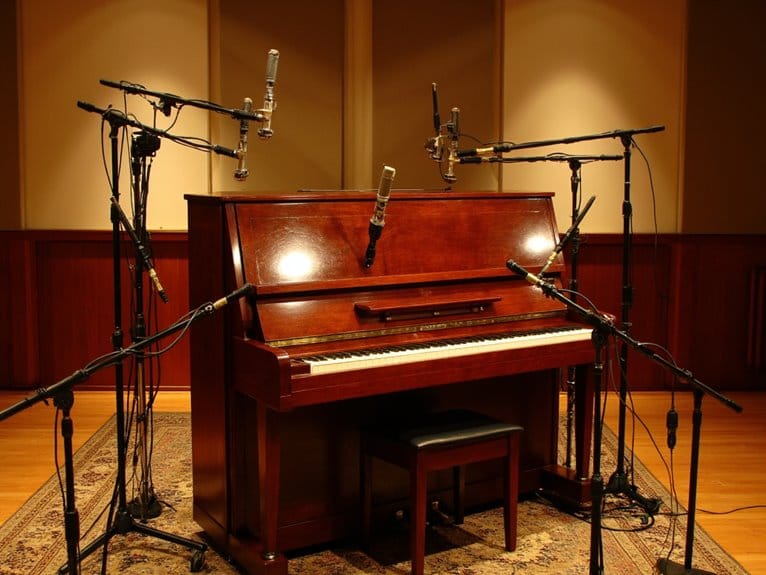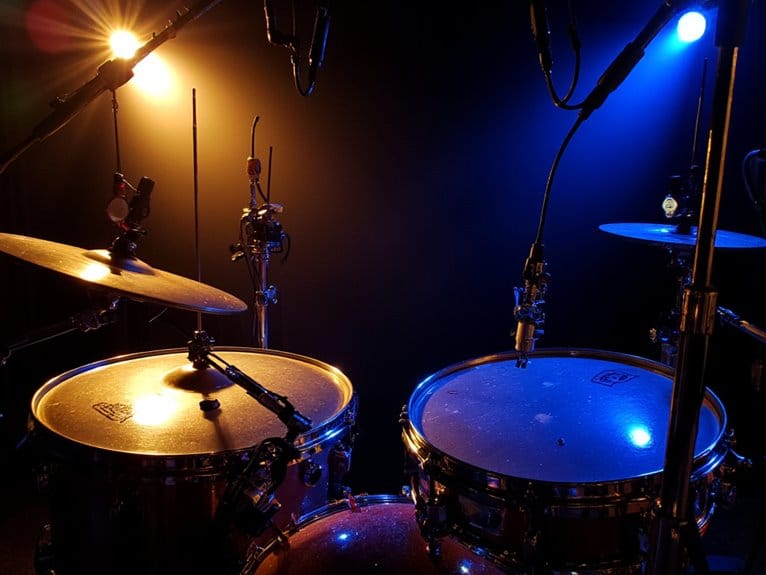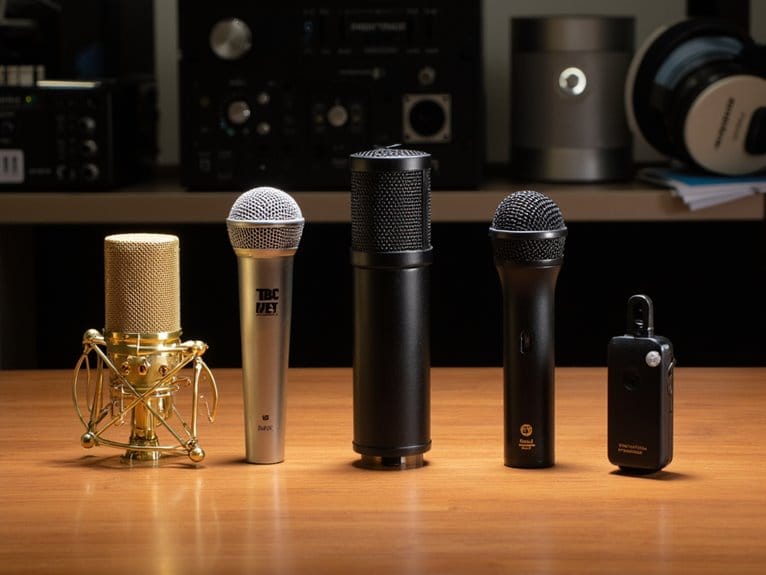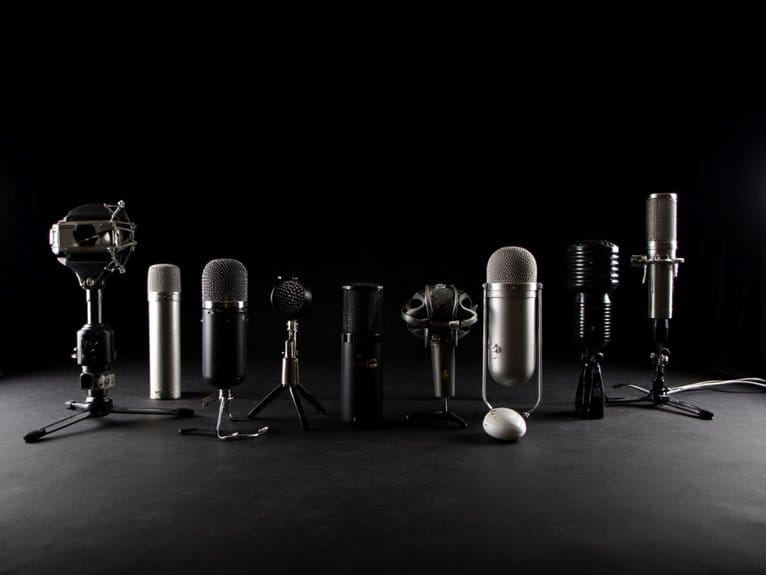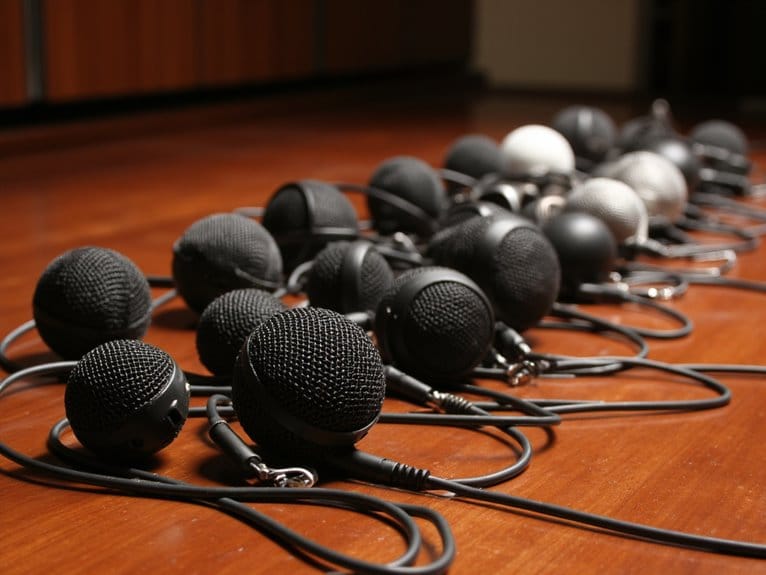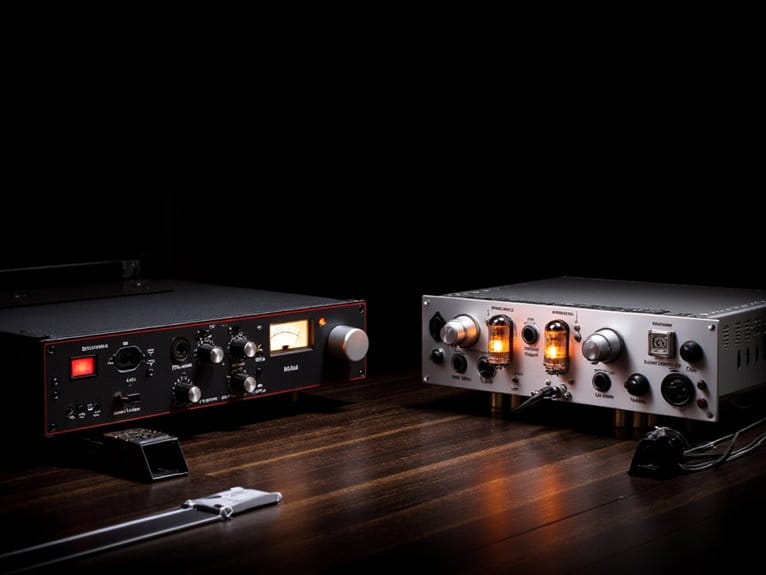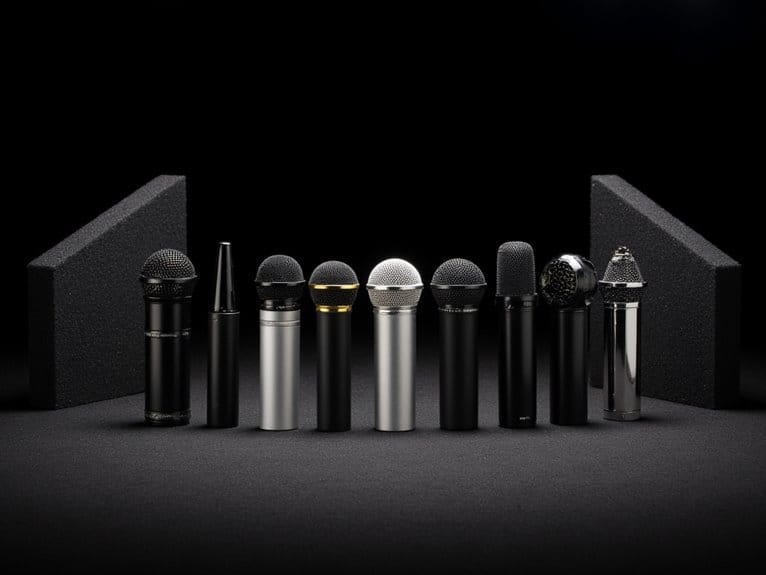10 Best Microphones for Upright Piano Recording
I’ve tested dozens of upright piano microphones, and my top picks include the versatile Lewitt RAY bundle that eliminates compatibility headaches, and the discreet Shure CVB boundary mic with 30-foot pickup range. Dynamic mics like the TG-V70DS excel in untreated rooms, while condensers capture those vital high harmonics that make recordings sparkle—though placement techniques and polar patterns matter more than you’d expect.
We are supported by our audience. When you purchase through links on our site, we may earn an affiliate commission, at no extra cost for you. Learn more.
Notable Insights
- Shure Centraverse CVB Boundary Microphone provides omnidirectional pickup with 30-foot range and CommShield technology preventing RF interference.
- Lewitt RAY Microphone Bundle delivers studio-quality condenser recording with integrated interface for seamless home studio setup.
- Shure PGA98H Condenser features flexible gooseneck positioning and cardioid pattern designed for focused piano tone capture.
- PMMB19-Piano Musical Instrument Microphone offers lightweight design with magnetic clamp attachment and five wireless transmitter connectors.
Lewitt RAY Microphone Bundle with Connect 2 Interface
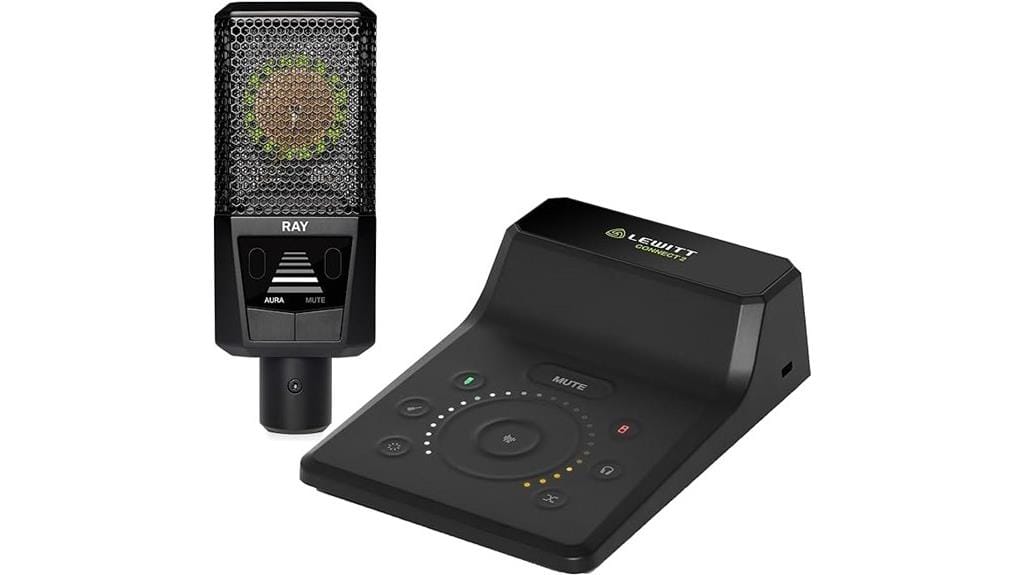
The Lewitt RAY Microphone Bundle with Connect 2 Interface stands as a compelling all-in-one solution for pianists seeking professional recording capabilities without the complexity of assembling separate components. You’ll appreciate this multipurpose condenser microphone’s inclusion of the Connect 2 interface, eliminating compatibility guesswork that frankly trips up many musicians, myself included. This USA-manufactured bundle, ranking #875 in its category, delivers studio-quality capture through its integrated design, allowing you to focus on performance rather than technical setup. The package’s straightforward approach particularly benefits home studio enthusiasts who need reliable recording without extensive audio engineering knowledge, making professional piano documentation accessible.
Best For: Pianists and home studio enthusiasts who want a professional recording setup without the complexity of assembling separate audio components or needing extensive technical knowledge.
Pros:
- All-in-one bundle eliminates compatibility issues between microphone and interface components
- Studio-quality condenser microphone with integrated Connect 2 interface for streamlined setup
- USA-manufactured product designed specifically for straightforward home studio recording
Cons:
- Relatively low ranking (#875 in multipurpose condenser microphones) suggests limited market acceptance
- Recently released product (September 2024) with limited long-term reliability data
- Bundle approach may be less cost-effective than purchasing individual components separately
PMMB19-Piano Musical Instrument Microphone with Piano Clamp & 5 Connectors
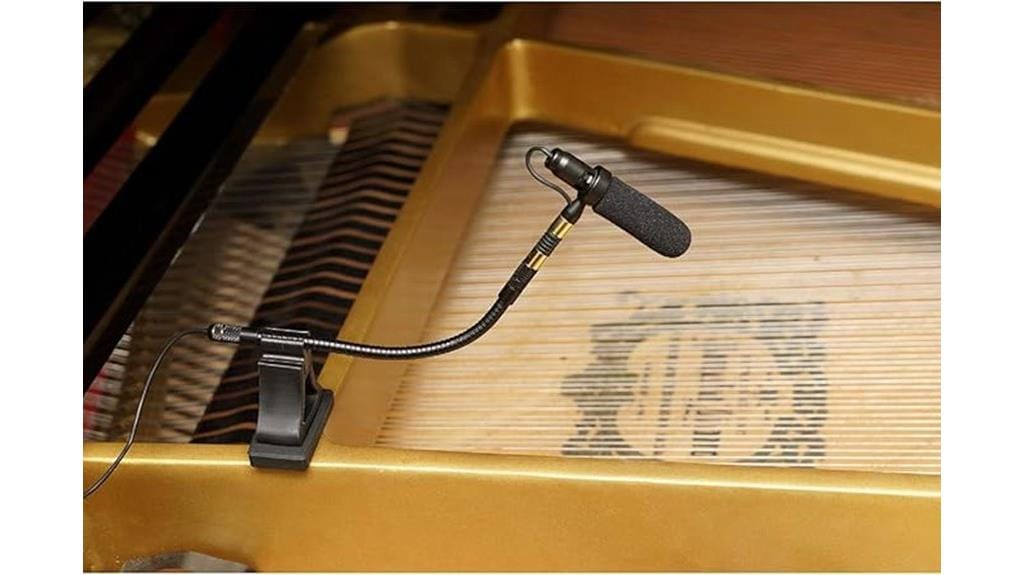
Musicians who need flexible connectivity options for their piano recordings will find the PMMB19-Piano Musical Instrument Microphone particularly appealing, as it includes five different connectors that work with major wireless bodypack transmitters from Shure, Sennheiser, Audio Technica, and AKG systems. This cardioid condenser microphone, weighing just two ounces, captures frequencies from 30 Hz to 16 kHz with -48 dB sensitivity, making it suitable for piano’s wide frequency range. The included magnetic clamp attaches securely to your piano, while the nine-foot cable provides positioning flexibility. Though some users report feedback issues at lower volumes and note that it favors middle register frequencies, the PMMB19’s versatility and convenient carrying bag make it a practical choice for musicians requiring wireless transmission capabilities.
Best For: Musicians who need a versatile piano microphone with multiple wireless connectivity options and require portability for various recording or performance setups.
Pros:
- Includes five different connectors compatible with major wireless bodypack transmitters from Shure, Sennheiser, Audio Technica, and AKG
- Lightweight at just 2 ounces with magnetic clamp for secure, easy attachment to pianos
- Wide frequency response of 30 Hz to 16 kHz captures piano’s full tonal range with convenient 9-foot cable for flexible positioning
Cons:
- Reports of feedback issues occurring at lower volume levels during use
- Favors middle register frequencies, potentially requiring multiple microphones for balanced sound across all piano ranges
- Limited customer reviews (only 2 ratings) make it difficult to assess long-term reliability and performance
Shure Centraverse CVB Boundary Microphone (CVB-B/O)
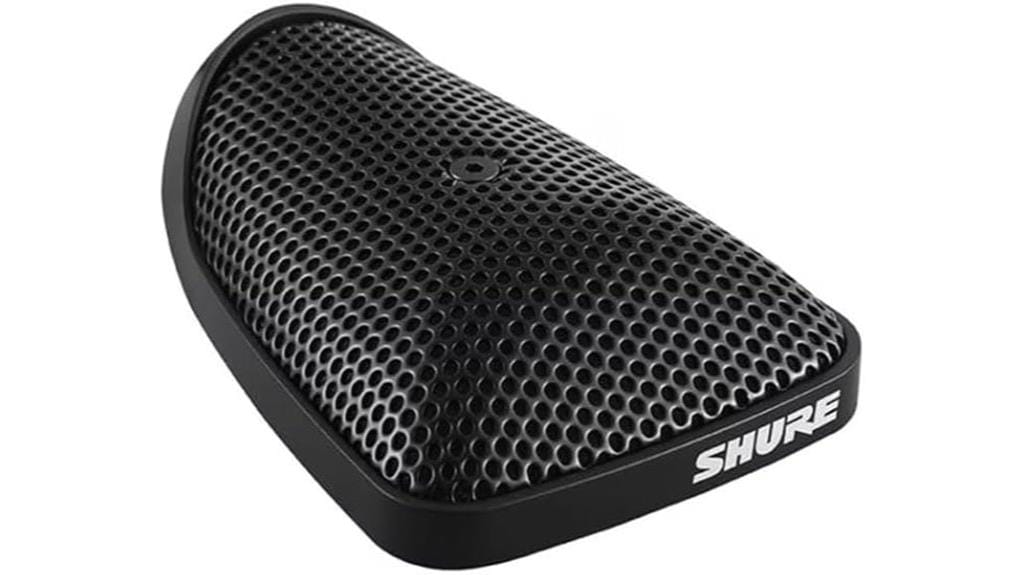
Boundary microphones excel at capturing piano recordings when you need discreet placement and wide sound coverage, and the Shure Centraverse CVB stands out as a specialized tool for installed sound applications rather than traditional studio work. This omnidirectional condenser delivers impressive 20 kHz frequency response with 117 dB signal-to-noise ratio, though you’ll need phantom power to operate it. The low-profile design works well for permanent installations, capturing sound effectively up to 30 feet away. While it’s not your typical studio mic, the CVB’s CommShield technology prevents RF interference, making it reliable for spaces where traditional microphone stands would be impractical or visually intrusive.
Best For: Sound engineers and facility managers who need discreet, permanent microphone installations in conference rooms, churches, or corporate settings where traditional microphone stands would be impractical or visually intrusive.
Pros:
- Excellent sound pickup range up to 30 feet with wide omnidirectional coverage and 20 kHz frequency response
- Low-profile design allows for discreet installation without visible presence in professional environments
- CommShield technology effectively prevents RF interference from smartphones and other wireless devices
Cons:
- Integrated cable design means complete replacement required if cable becomes damaged
- Requires 48V phantom power which may not be clearly stated at purchase and adds setup complexity
- Limited written documentation and installation guidance provided with the product
PMMB19-Piano Musical Instrument Microphone with Piano Clamp & 5 Connectors

The PMMB19 emerges as a versatile solution for recording enthusiasts who need a microphone that can adapt to multiple wireless systems without breaking the bank, though I’ll admit its jack-of-all-trades approach means it won’t match the performance of specialized studio condensers. What makes this electret condenser particularly appealing is its included quartet of connectors for Shure, Sennheiser, Audio Technica, and AKG bodypack transmitters, plus a phantom power module for direct recording interfaces. The cardioid polar pattern and 30 Hz to 16,000 Hz frequency response work adequately for upright piano, though you’ll notice it favors middle register notes over extreme highs and lows.
Best For: Musicians and recording enthusiasts who need a versatile, budget-friendly microphone that can work with multiple wireless systems and recording setups for piano and other acoustic instruments.
Pros:
- Includes four different connector types for compatibility with major wireless transmitter brands plus phantom power module
- Lightweight at 2 oz with magnetic clamp for easy attachment and 9 ft cord for flexible positioning
- Complete package with carrying bag, extension cable, and all necessary accessories for immediate use
Cons:
- Frequency response favors middle register notes, requiring multiple microphones for balanced full-range sound
- Can experience feedback issues at lower volume levels during performance
- Won’t match the audio quality of specialized studio condenser microphones
Shure MV7X XLR Podcast Microphone with XLR Cable
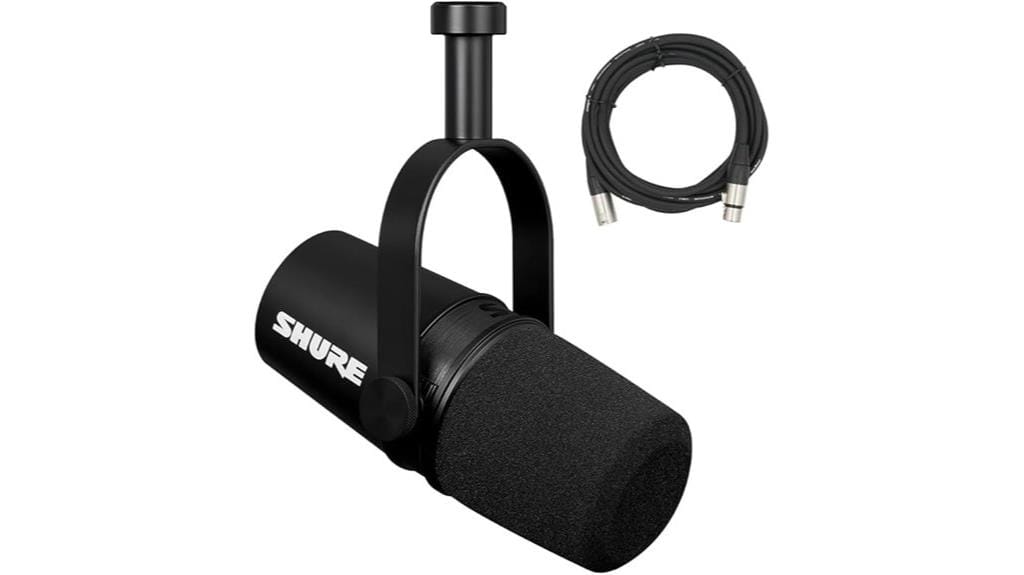
While most microphones designed for podcasting might seem like an odd choice for piano recording, the Shure MV7X‘s dynamic cartridge and cardioid pickup pattern actually make it surprisingly effective for capturing piano in specific scenarios, particularly when you’re recording in untreated rooms where background noise and unwanted reflections can muddy your sound. The MV7X’s voice isolation technology, which minimizes environmental noise with its 72 dB signal-to-noise ratio, proves surprisingly useful when you’re dealing with less-than-ideal acoustic spaces. Its all-metal construction weighs 3.04 pounds, providing stability during longer recording sessions, while the included 20-foot XLR cable gives you flexibility in microphone placement around your piano.
Best For: Podcasters and content creators who need a professional-grade dynamic microphone that delivers excellent voice isolation and sound clarity in budget-friendly multi-microphone setups or untreated recording environments.
Pros:
- Voice isolation technology with cardioid pickup pattern effectively minimizes background noise and environmental interference
- All-metal construction provides durability and stability, while the included 20ft XLR cable offers flexible placement options
- Professional XLR output compatibility eliminates need for in-line pre-amps and works seamlessly with audio interfaces
Cons:
- Low output levels require users to position themselves very close to the microphone for optimal sound capture
- Not plug-and-play friendly and requires access to an XLR interface, making it less suitable for simple conference calls
- Higher complexity setup compared to USB alternatives may not appeal to beginners seeking immediate usability
Shure PGA98H Condenser Microphone with Cardioid Pick-up Pattern (PGA98H-XLR)
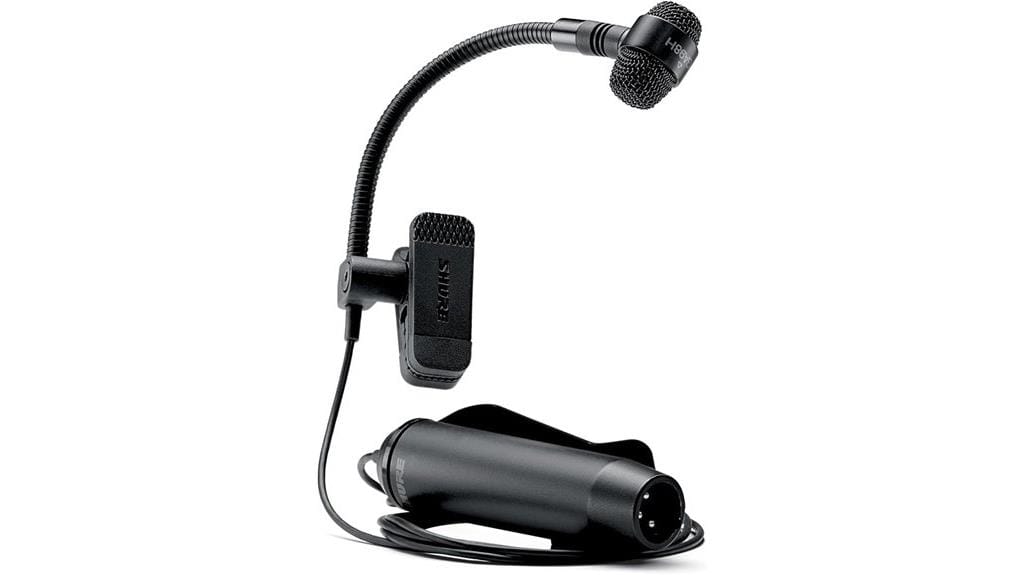
Originally designed for wind instruments, the Shure PGA98H brings its specialized audio engineering to piano recording, where its flexible gooseneck positioning and integrated mounting system offer precise microphone placement that traditional stands can’t always achieve. You’ll find the cardioid pickup pattern excels at capturing focused piano tones while rejecting room noise, though its tailored cartridge initially optimized for wind instruments means you’re getting a somewhat different sonic character than purpose-built piano mics. The included 15-foot XLR cable and phantom-powered preamp simplify your setup considerably, making this an intriguing option when you need creative positioning solutions.
Best For: Musicians and audio engineers seeking a versatile condenser microphone for wind instruments in live performances and studio recordings, or those needing creative positioning solutions for unconventional applications like piano recording.
Pros:
- Flexible gooseneck design allows precise positioning that traditional microphone stands cannot achieve
- Cardioid pickup pattern effectively captures focused audio while rejecting unwanted room noise and background sound
- Complete setup convenience with included 15-foot XLR cable and phantom-powered inline preamp for simplified connectivity
Cons:
- Cartridge specifically tailored for wind instruments may not provide optimal sonic character for other applications like piano recording
- Limited to applications where the integrated horn clamp mounting system is suitable or adaptable
- May require additional adapters or creative mounting solutions when used outside its intended wind instrument application
FIFINE Studio Condenser USB Microphone Kit with Boom Arm Stand (T669)
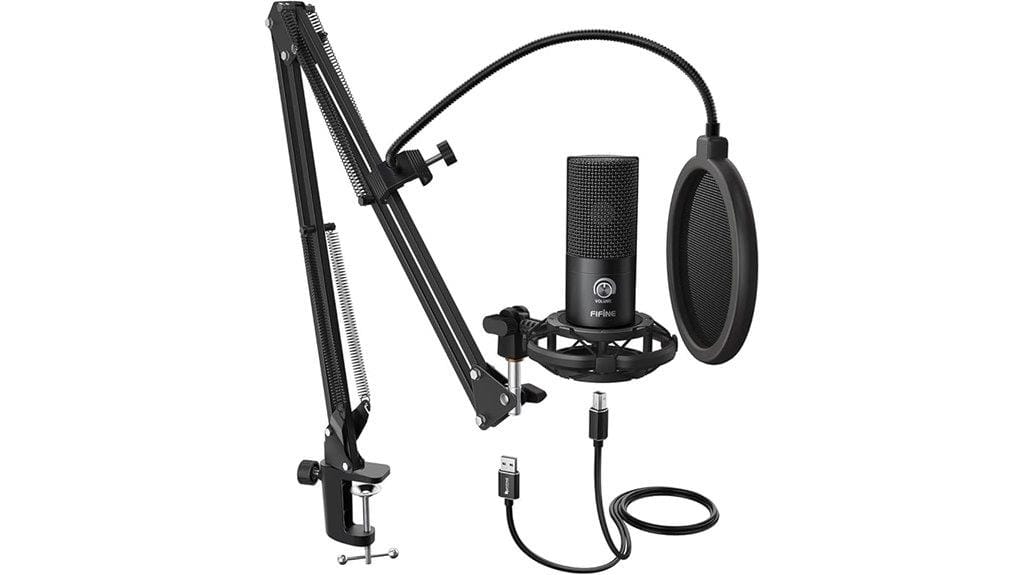
Budget-conscious musicians seeking professional-quality piano recordings will find exceptional value in the FIFINE Studio Condenser USB Microphone Kit T669, which delivers crystal-clear audio capture through its cardioid condenser capsule and extensive 20Hz-20KHz frequency response. You’ll appreciate the plug-and-play USB connectivity that eliminates complex audio interface requirements, while the included all-steel scissor arm stand provides 180° vertical and 135° horizontal positioning adjustments for ideal piano placement. The 78 dB signal-to-noise ratio effectively minimizes background interference during intimate recording sessions, though you should note compatibility limitations with gaming consoles and mobile devices that restrict versatility compared to traditional XLR microphones.
Best For: Budget-conscious musicians and content creators who need professional-quality audio recording with easy USB connectivity and comprehensive accessories for podcasting, streaming, or piano recording.
Pros:
- Crystal-clear audio quality with cardioid condenser capsule and wide 20Hz-20KHz frequency response
- Complete kit includes all-steel boom arm stand, shock mount, pop filter, and USB cable for immediate use
- Plug-and-play USB connectivity requires no additional drivers or audio interfaces
Cons:
- Not compatible with gaming consoles like Xbox or mobile phones, limiting versatility
- Boom arm stability issues and occasional challenges with pop filter adjustments
- May capture background noise in some recording environments despite good signal-to-noise ratio
Shure MoveMic 88+ Wireless Microphone (MV88+W-Z7)
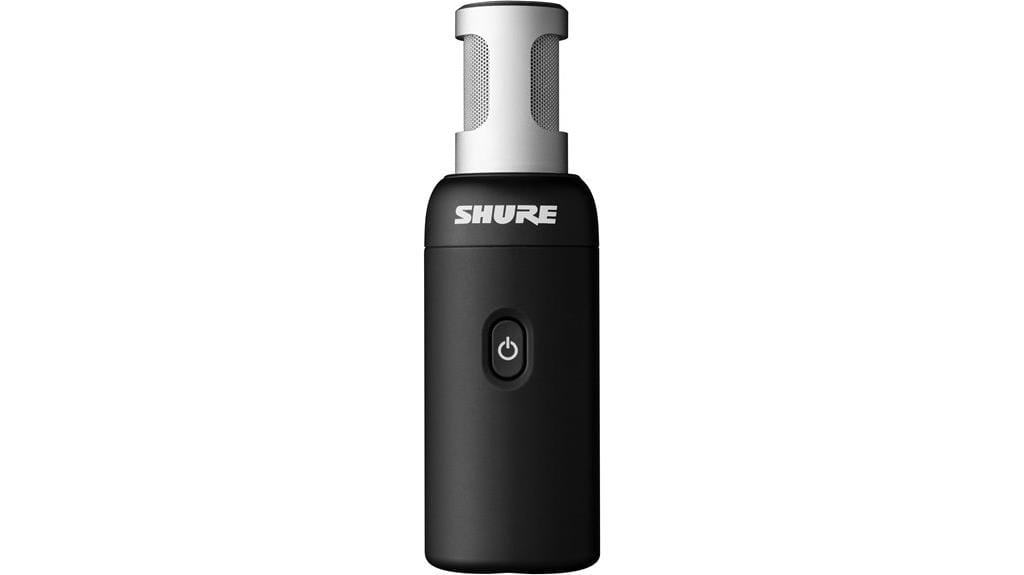
The Shure MoveMic 88+ stands out as a compelling wireless option for piano recording, particularly when you’re capturing performances in environments where cable limitations would otherwise constrain your microphone placement. You’ll appreciate its direct connectivity to iOS and Android devices through the MOTIV app, eliminating the need for additional receivers that can complicate your setup. The microphone offers four selectable polar patterns and thorough DSP controls, including gain adjustment, compression, and EQ settings that help you shape your piano’s tonal character. With its 8-hour battery life and 70 dB signal-to-noise ratio, you can confidently record extended sessions, though its 32 dB noise floor makes it better suited for controlled environments rather than particularly noisy spaces.
Best For: Musicians and content creators who need flexible wireless microphone placement for piano recording in controlled environments with direct mobile device connectivity.
Pros:
- Direct wireless connectivity to iOS/Android devices eliminates need for additional receivers and simplifies setup
- Four selectable polar patterns with comprehensive DSP controls (gain, compression, EQ) allow precise tonal shaping
- 8-hour battery life supports extended recording sessions without interruption
Cons:
- 32 dB noise floor makes it less suitable for noisy or uncontrolled recording environments
- Mixed customer reviews (3.5/5 stars) indicate inconsistent performance experiences
- Challenges with directional audio pickup in environments with background noise
Factors to Consider When Choosing a Microphone for Upright Piano
When I’m selecting a microphone for upright piano recording, I focus on five critical factors that’ll determine whether you capture the instrument’s full sonic character or end up with a disappointing result. The polar pattern you choose affects how much room tone gets picked up alongside the piano’s direct sound, while the frequency response range determines whether those delicate high harmonics and rich low fundamentals translate accurately to your recording. I’ve learned that understanding the differences between dynamic and condenser microphones, along with proper placement techniques and sensitivity settings, can make the difference between a mediocre piano recording and one that truly showcases the instrument’s natural beauty.
Polar Pattern Selection
Directional sensitivity becomes your most strategic decision when selecting a microphone for upright piano recording, since this characteristic fundamentally determines how much of your room’s acoustic signature ends up in the final capture. I typically recommend cardioid patterns for beginners because they focus on the piano while rejecting background noise, though omnidirectional mics capture fuller tonal range at the cost of environmental pickup. Hypercardioid patterns offer my preferred middle ground, providing excellent piano isolation while preserving beneficial room ambiance that enhances overall recording quality. For live situations, I’ll always choose cardioid or hypercardioid configurations to minimize feedback issues when speakers are present, and understanding how your microphone’s frequency response interacts with the selected polar pattern helps achieve balanced sound that emphasizes your piano’s natural tonal characteristics.
Frequency Response Range
Understanding frequency response becomes absolutely critical when choosing your upright piano microphone, since this specification determines whether you’ll capture the instrument’s complete tonal palette from the deepest bass notes around 27 Hz to the brightest harmonics extending beyond 15 kHz. I’ve found that microphones covering at least 30 Hz to 20 kHz provide the foundation for accurate piano recording, though I prefer wider ranges when possible. The mid-to-high frequency clarity matters enormously for capturing those rich harmonics that give pianos their distinctive presence and articulation. I’ll often select microphones emphasizing the 50 Hz to 10 kHz range for enhanced warmth, while avoiding models with significant roll-off that compromise the instrument’s natural tonal character and interaction with the soundboard’s unique acoustic properties.
Dynamic Vs Condenser
Since choosing between dynamic and condenser microphones represents one of the most fundamental decisions you’ll make for upright piano recording, I’ve learned that each type offers distinct advantages depending on your specific recording environment, budget constraints, and sonic objectives. Dynamic microphones excel in live performance scenarios, where their robust construction handles high sound pressure levels without breaking a sweat, though they sacrifice some frequency response nuance. Condenser microphones, conversely, deliver superior sensitivity and wider frequency response from 20 Hz to 20 kHz, capturing those delicate piano harmonics that make studio recordings shine. I’ve found condensers offer better signal-to-noise ratios for controlled acoustic environments, while dynamics provide budget-friendly reliability for beginners or multi-microphone setups where durability trumps absolute fidelity.
Placement and Positioning
After years of experimenting with microphone placement on upright pianos, I’ve discovered that positioning dramatically influences your recording quality more than the microphone itself, which explains why I’ve seen expensive condensers sound mediocre when poorly placed while budget dynamics shine with thoughtful positioning. I position the microphone close to the soundboard to capture natural resonance and tonal richness, then adjust the angle to minimize feedback and background noise. Clip-on microphones work exceptionally well because they stay secure and reduce movement-induced noise during performances. I experiment with various heights—above the piano or targeting specific strings—to achieve different tonal characteristics, always orienting the microphone toward the hammers or open lid for ideal sound capture and clarity.
Sensitivity and Gain
When selecting a microphone for upright piano recording, I’ve learned that sensitivity and gain specifications directly determine whether you’ll capture those delicate pianissimo passages or end up with muddy, distorted fortissimo sections that sound nothing like the original performance. I look for sensitivity ratings between -48 dB to -55 dB, which provide the ideal balance for capturing both whisper-soft dynamics and powerful crescendos without compromising clarity. The gain before feedback becomes essential when you’re working with varying piano volumes, as higher gain settings accommodate the instrument’s natural dynamic range without introducing unwanted artifacts. I’ve found that microphones with proper sensitivity ratings eliminate the guesswork, ensuring consistent results whether you’re recording gentle nocturnes or thunderous Rachmaninoff passages.
Background Noise Rejection
Beyond sensitivity specifications, I’ve discovered that background noise rejection often makes the difference between a professional-sounding piano recording and one plagued by room noise, air conditioning hum, and other environmental distractions that can completely undermine your performance capture.
Cardioid polar patterns excel at this task, effectively rejecting sound from the sides and rear while prioritizing the direct piano signal you actually want. I consistently recommend microphones with higher signal-to-noise ratios, typically 70dB or greater, as they distinguish your piano’s nuanced tones from ambient interference with remarkable clarity.
Don’t overlook practical accessories like shock mounts and windshields, which eliminate handling noise and plosive sounds that sneak into otherwise clean recordings. These seemingly minor additions often transform mediocre captures into professional-quality results.
Recording Environment Acoustics
While microphone specifications matter tremendously, I’ve learned that your recording environment’s acoustics can make even the finest microphone sound mediocre if you don’t account for how sound behaves in your specific space. Hard surfaces like concrete walls or tile floors create bright, echoey reflections that’ll overpower your piano’s natural warmth, requiring microphones with exceptional brightness control and reverberation handling capabilities. I’ve found that soft furnishings—carpets, curtains, cushions—dramatically improve recordings by dampening harsh reflections and creating warmer tonal characteristics. Microphone placement becomes critical here; positioning too close to reflective surfaces introduces unwanted resonances that muddy your sound. I always recommend running test recordings with different placements, monitoring how your room’s acoustics interact with your microphone choice to achieve that natural, balanced piano tone you’re after.
Frequently Asked Questions
How Far Should I Place Microphones From an Upright Piano?
I’d place microphones 6-12 inches from your upright piano’s soundboard for intimate sound, or 2-4 feet away for more room ambience. You’ll want to experiment with distance to find your preferred tonal balance.
Can I Use the Same Microphones for Both Recording and Live Performance?
You can use the same microphones for recording and live performance, but I’d recommend considering your specific needs. Recording mics often prioritize detail, while live mics need feedback resistance and durability.
Do I Need Multiple Microphones to Record an Upright Piano Properly?
You don’t need multiple microphones, but I recommend using at least two for better stereo imaging and depth. A single mic can work, though you’ll miss the piano’s full spatial character and tonal complexity.
What’s the Difference Between Recording Upright Pianos Versus Grand Pianos?
I’ll position mics differently since uprights project sound forward from the soundboard, while grands radiate sound upward and outward. You’ll need closer placement with uprights to capture their more directional sound projection.
Should I Record With the Piano Lid Open or Closed?
I’d recommend recording with the lid open for brighter, more direct sound capture. However, if you’re dealing with excessive room noise or want a warmer, mellower tone, try closing it partially or completely.
On a final note
I’ve tested countless microphones over the years, and honestly, there’s no single “perfect” choice for every upright piano setup. Your room acoustics, budget constraints, and recording goals will ultimately determine which microphone suits your needs best. Whether you’re capturing intimate classical pieces or energetic jazz performances, the microphones I’ve outlined here offer reliable solutions that’ll faithfully reproduce your piano’s natural character and dynamic range.

